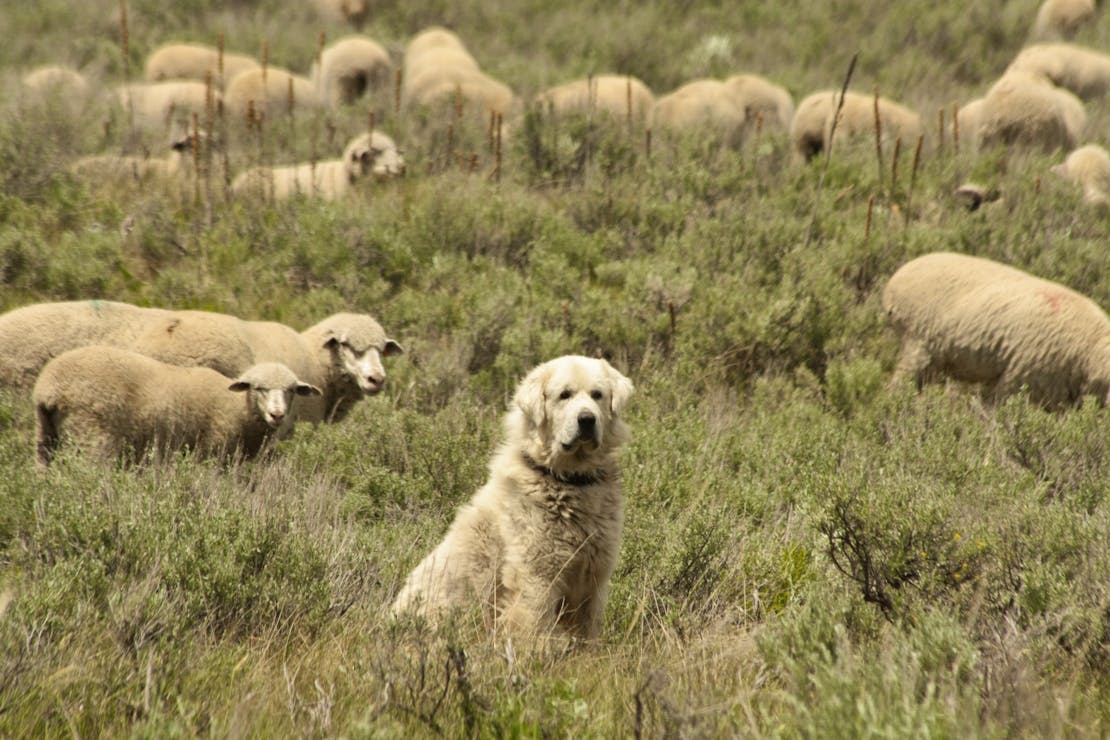How Livestock Guardian Dogs Help Producers and Wildlife Coexist
A herd of sheep grazes on the fresh, spring grass outside the barn. Two young lambs play near their mothers while the ewes munch away. A few other ewes several feet away lay together in the shade. Except one of those animals isn’t a sheep… it’s a large, fluffy white dog!
Meet the livestock guardian dogs
Livestock guardian dogs are working dogs whose primary job is to protect their herd. As young puppies, they are placed with their rancher or producer’s livestock – usually sheep or cows – with which they bond. These dogs are not pets and do not usually come inside the house, but rather they live with the livestock. The cows or sheep become the guardian dog’s family and in return the dogs protect the herd.
Guardian dogs are bred for this lifestyle. Breeds commonly used include Kangal, Akbash and Anatolian. All are large and have a more protective – or even aggressive – nature than your typical house pet. That’s not to say these dogs do not have positive interactions with their owners, because that’s who feeds them!
“Stay away from my herd!”
Since guardian dogs are bred for the job, there is limited direct training the producer needs to do with the dog. The most important thing these dogs need to learn is the boundaries of their territory. If a predator were to encroach onto the ranch, the dogs will start barking. Their job is not to attack or fight the predator but rather to deter it.
For example, a sheep could be an easy meal for a wolf on the hunt without any deterrents on the property. A guardian dog making a ton of noise and posing a threat to the wolf with its nature and size has a higher chance of turning the wolf away in search of an easier meal. The barking also alerts the humans on the premises and wolves are most likely to leave when a human presence is near.
Livestock guardian dogs are mostly and intentionally used to deter predators such as wolves. They have been successfully used for thousands of years to protect livestock across the globe.
“Good boys and girls” work alongside multiple deterrents
Guardian dogs are a very effective and successful tool for ranchers to use, but like all tools they too have their limits. One key challenge with these dogs is they are most effective on the home ranch, but conflicts with wolves can happen on the summer pasture too. Instead of a 1,000-acre ranch, summer pastures may be on a 50,000-acre Forest Service allotment or other public land. The cattle or sheep are often more dispersed than at home and the dogs may not know this territory as well.
The size of the herd also varies, with summer herds being larger with young. Many ranchers sell off a portion of their animals in the fall and therefore have a smaller herd in winter. The livestock guardian dogs will still do their best to protect their herd, but to be as effective as possible, a livestock producer will use multiple deterrents throughout the year.
One example of a good tangential tool is fladry. Unlike a guardian dog, who is used year-round, fladry is most effective when used for not more than about six weeks. A producer may put fladry up during his herd’s most vulnerable time: calving. For the first six weeks or so that the fladry is up, wolves are incredibly reluctant to cross it. After that amount of time though, the wolves may begin to lose their fear and realize the fladry doesn’t pose an actual threat to them.
Other tools that may also be deployed include fox lights, air horns, radio-activated guard (RAG) boxes and increased human presence like range riders.
A pack effort
Defenders of Wildlife first advocated for and supported livestock guardian dog programs in 1984. In fact, this program is among the first coexistence activities for which Defenders directly advocated. Our coexistence work today has expanded to include additional on-the-groundwork, funding and implementing many of the other non-lethal tools, like fladry, as well as outreach and education efforts with the local communities living alongside wildlife.
Join our pack! You can help us fund and implement coexistence tools, including livestock guardian dogs. When we work together, we can all be guardians.







